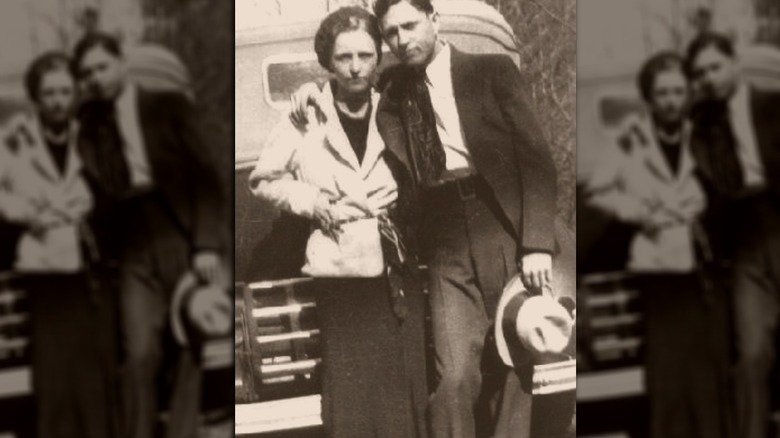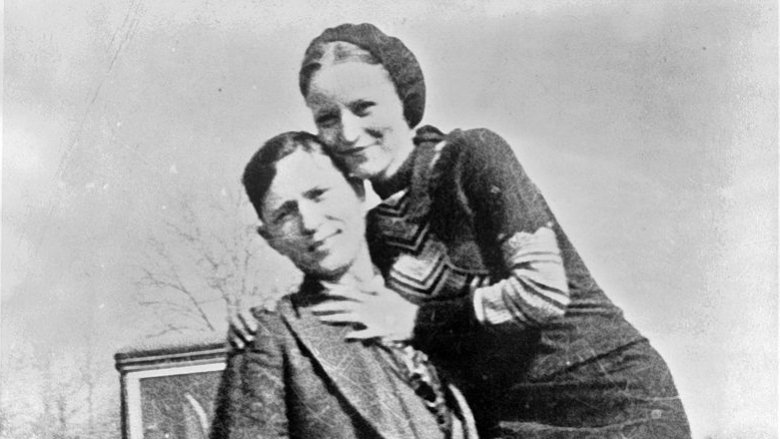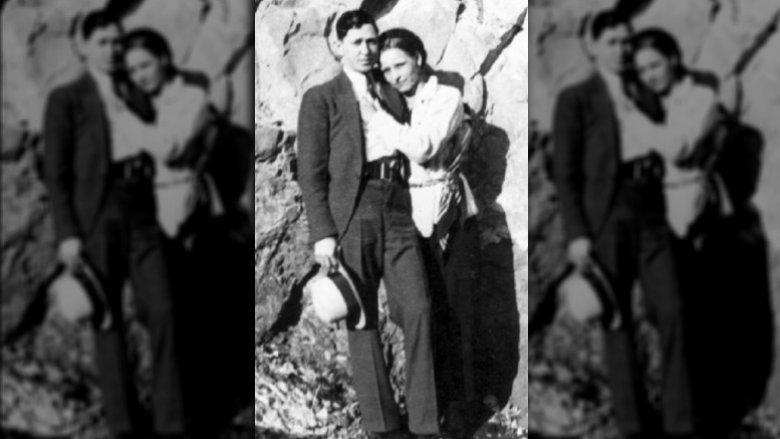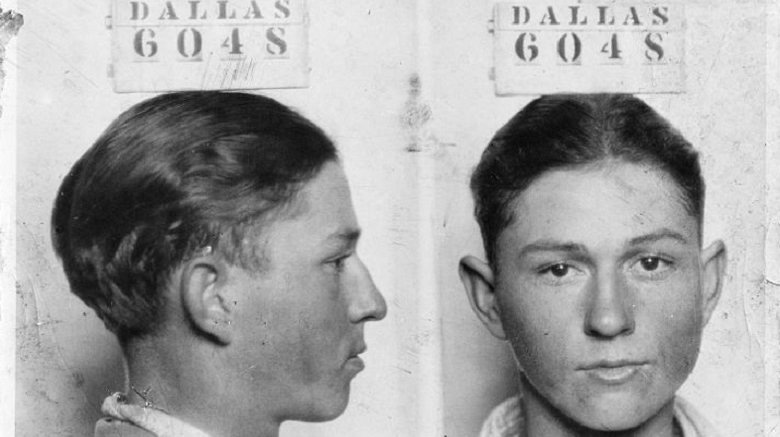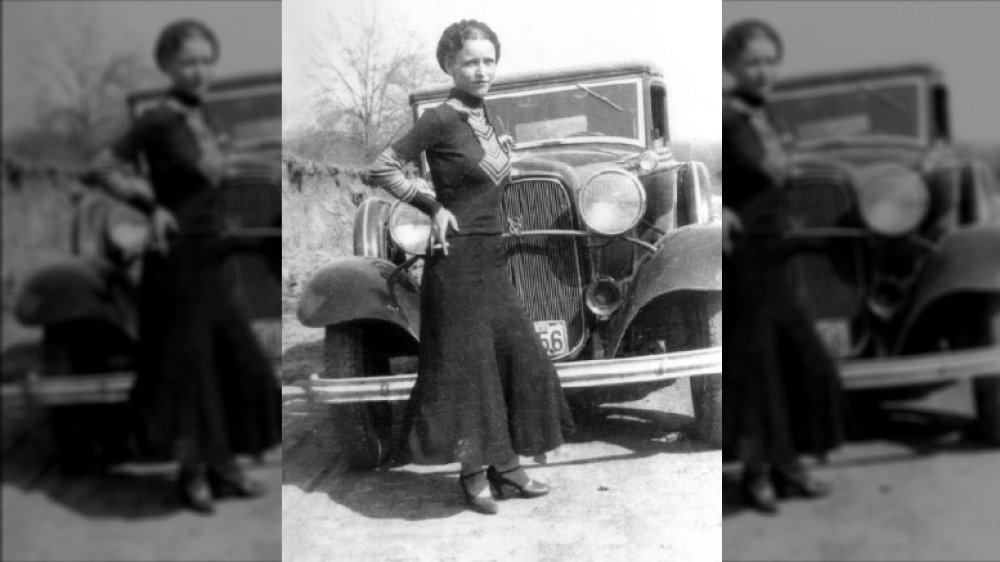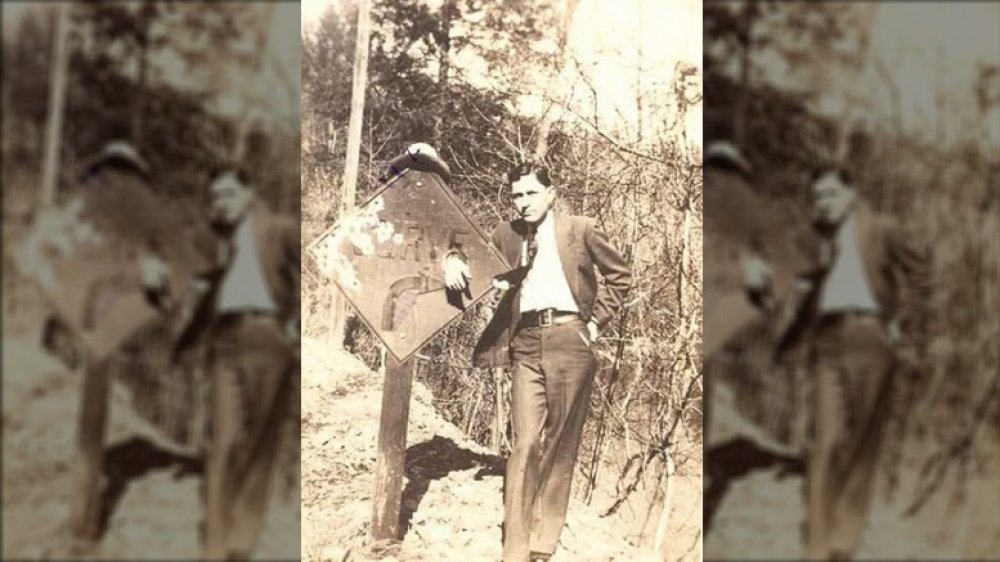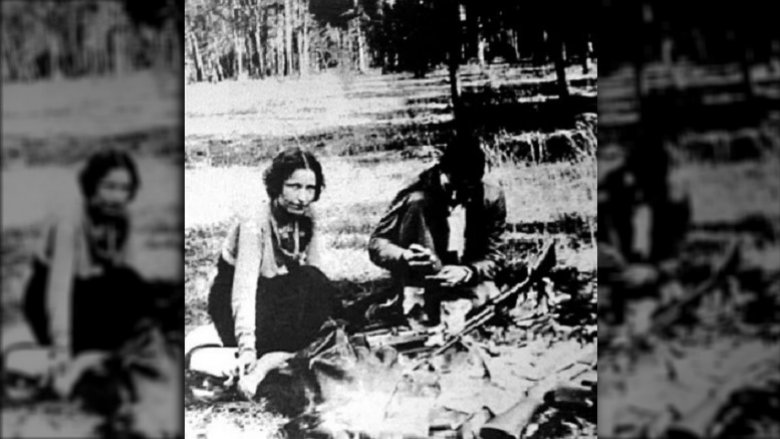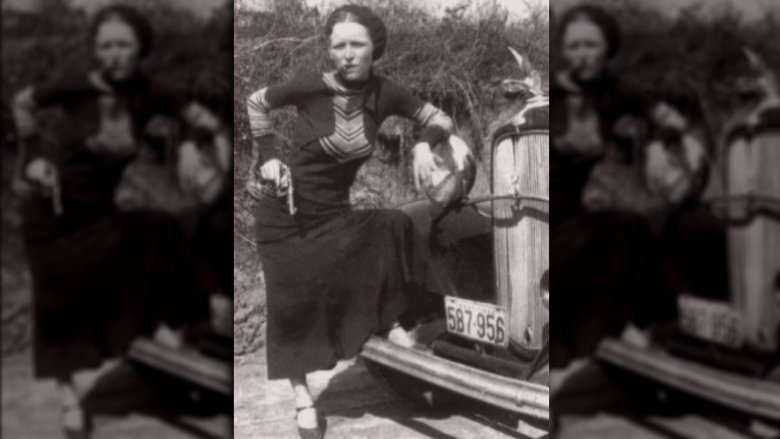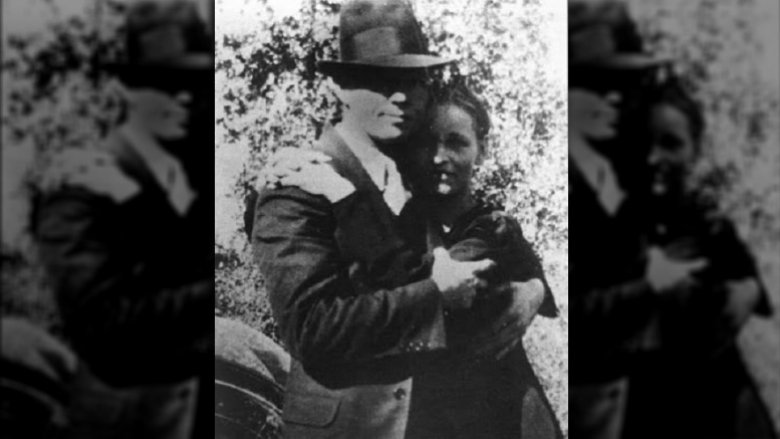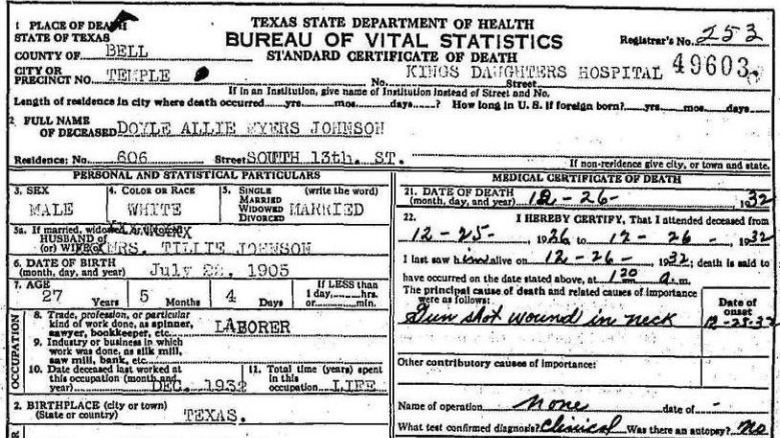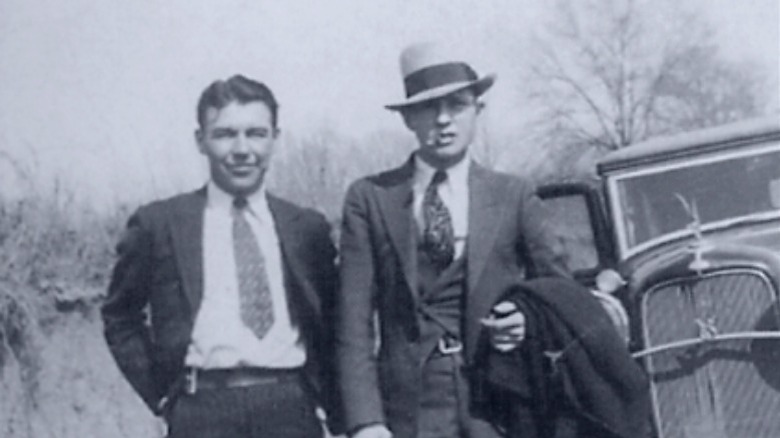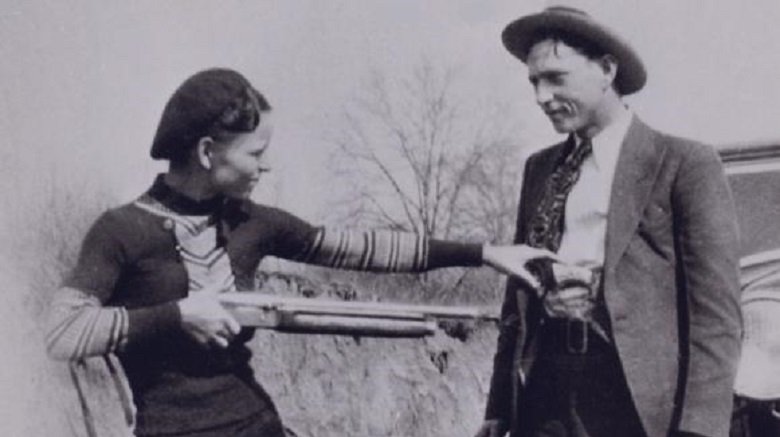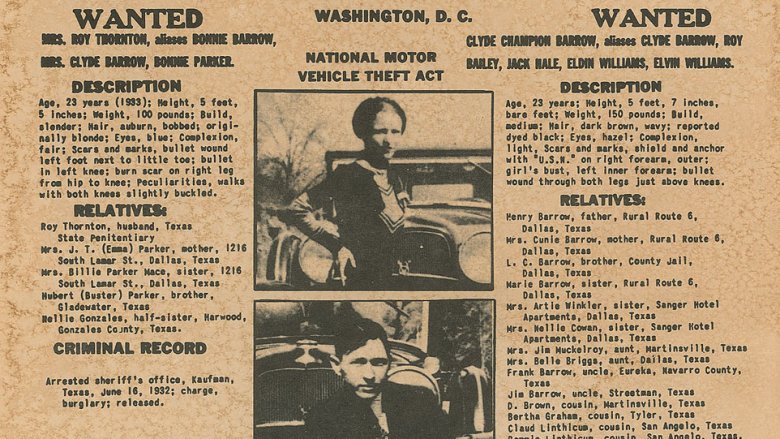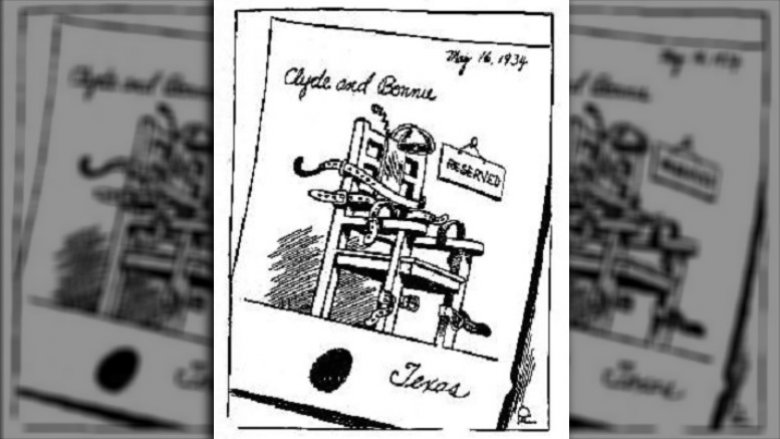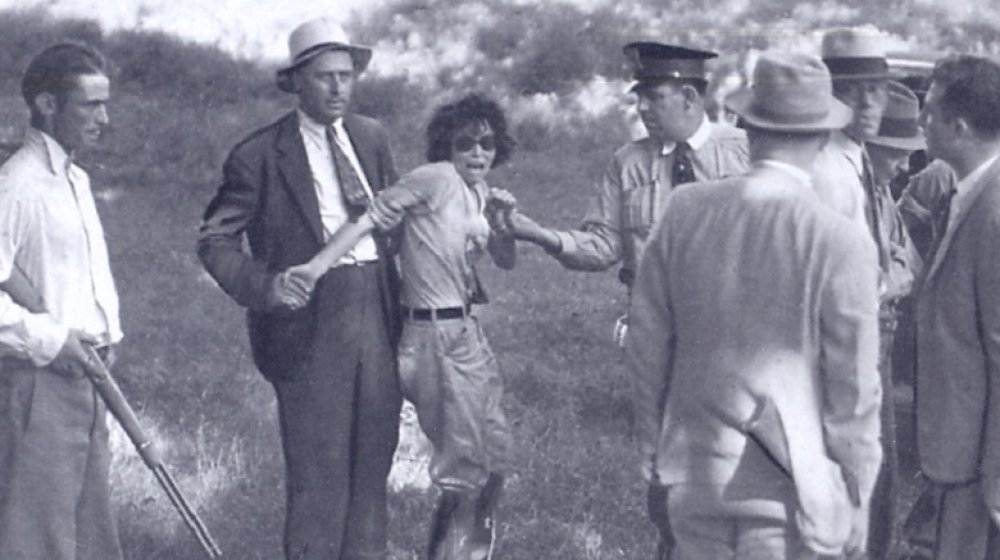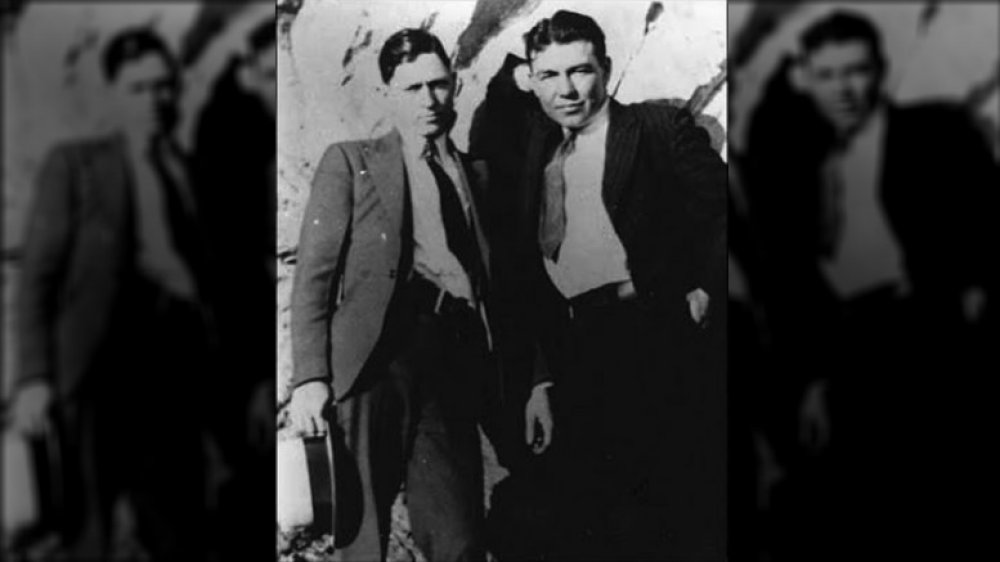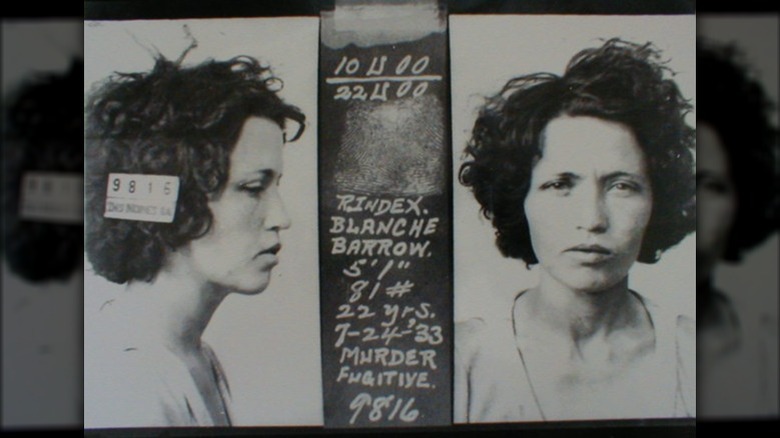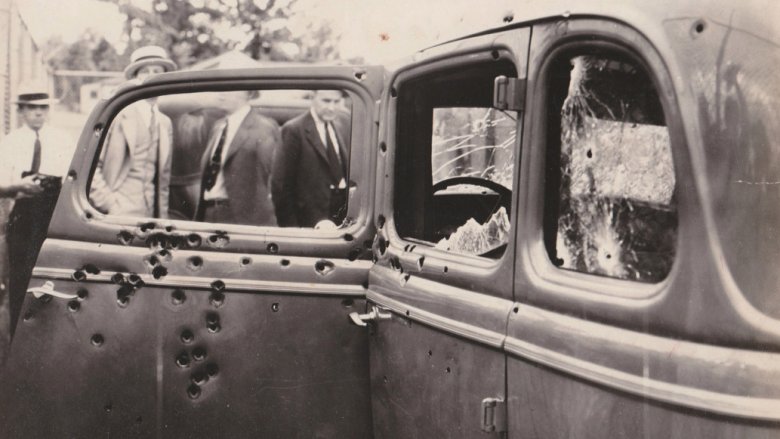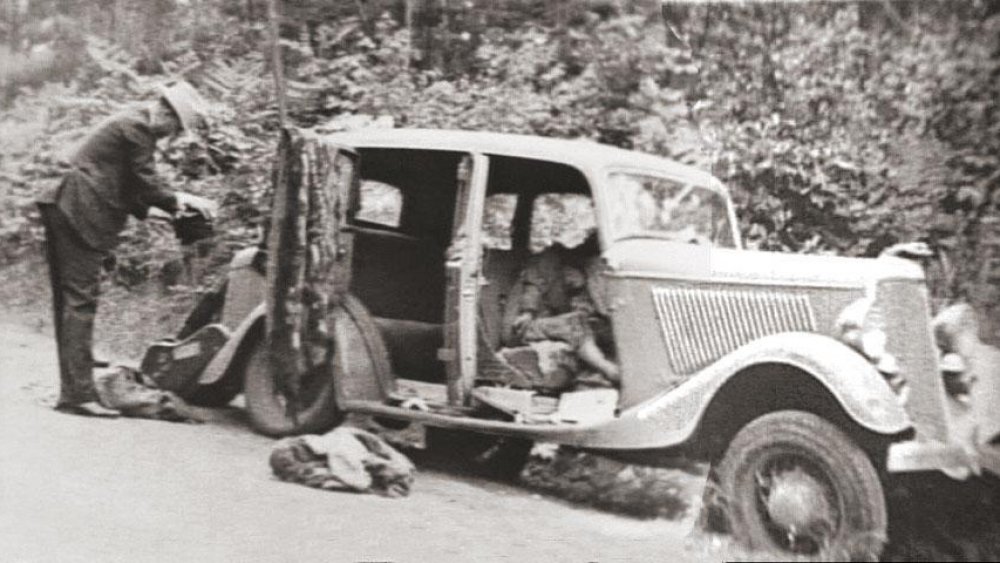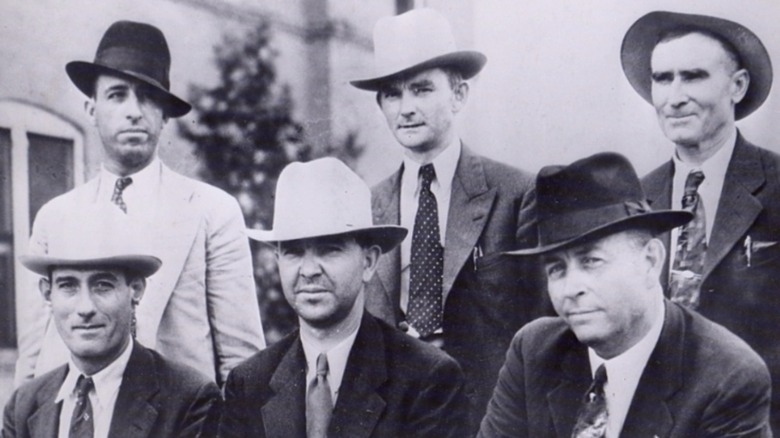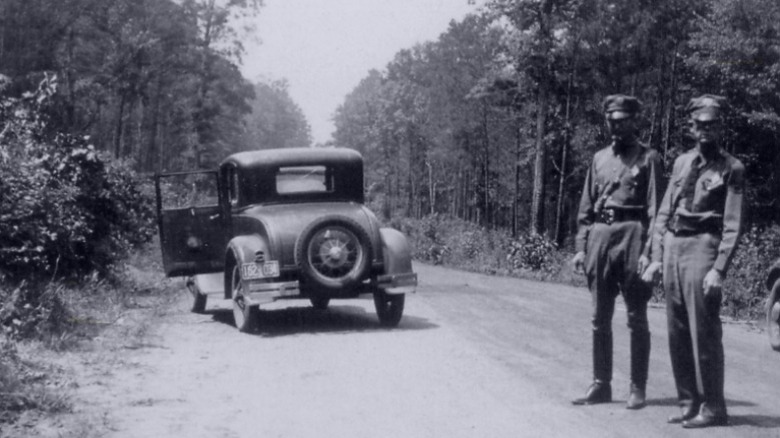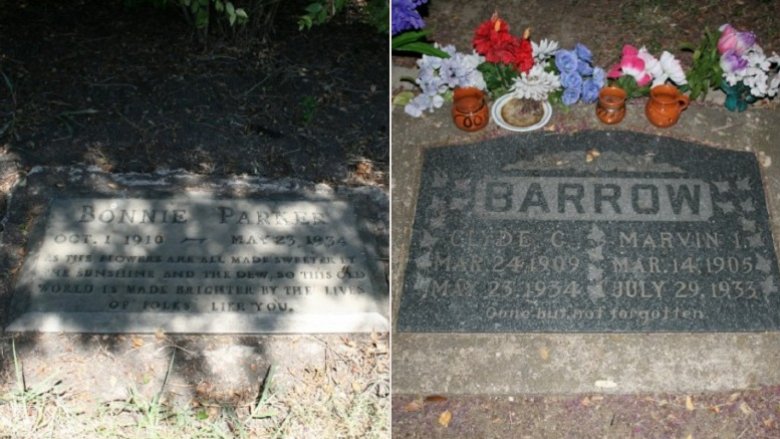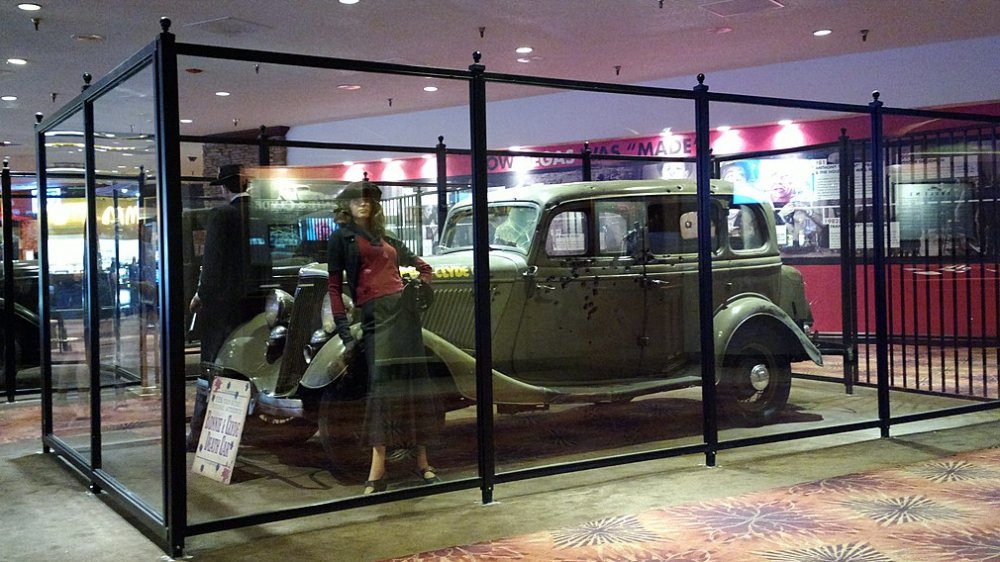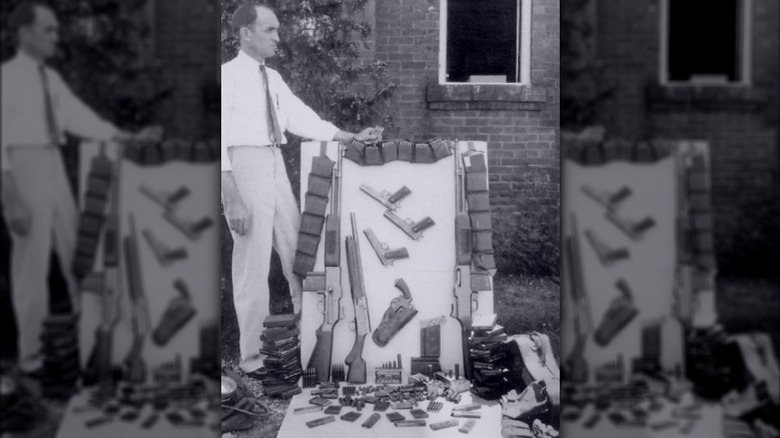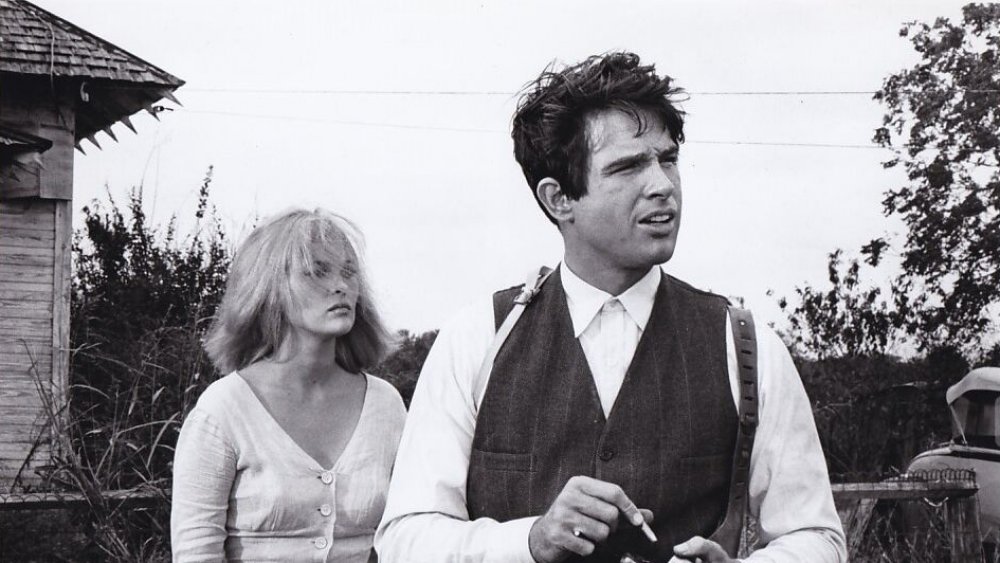The Untold Truth Of Bonnie And Clyde
Bonnie and Clyde are perhaps the most romanticized outlaws of all time. At a time when gangsters and bad guys were celebrities, they stood out. No one knows who Al Capone's or John Dillinger's lady friends were off the top of their heads; the fact that Bonnie and Clyde committed crimes as a couple made them special. Clyde Barrow and Bonnie Parker met in 1930, and later went on a 21-month spree. Once they got started, they tore across various Southern states, leaving death and destruction in their wake. Yet the public was obsessed with them, this sexy young couple taking on the police and the banks, two of the most hated institutions in Prohibition- and Great Depression-era America.
But of course, there's more to the story. Bonnie and Clyde were real people, with complicated and tragic pasts. Their love affair was more than a little twisted. And their crime spree wasn't as impressive as it's gone down in legend. Here are the things the movies don't tell you.
Bonnie and Clyde could have been famous by more traditional means
While Bonnie and Clyde ended up becoming famous by killing people and robbing banks, they probably could have taken the legal route. Both were talented in more traditional ways.
According to Bonnie and Clyde's Hideout, Clyde had a "natural music ability." His brother-in-law taught him to play the saxophone, and he also played guitar. It's said he "brought a little happiness into the lives of others sentenced to poverty" when he'd strum the guitar around the fire at camps the couple stayed at while on the run. When one of their safehouses was raided, Clyde's guitar was left behind, and he asked his mother to try and get it back to him. She failed, but he did manage to hold onto his sax. It was actually in the car, along with sheet music, when he and Bonnie were killed.
Bonnie was the one who actively wanted to be famous, though. The producers and writers of two different movies about Bonnie and Clyde all said she wanted to be a celebrity by any means necessary, whether it was as a Broadway star, a singer, a Hollywood actress, or even a poet. And she did have talent; growing up she starred in school plays and pageants, including one where Texas Monthly reports that a boy upstaged her, so she punched him. When the audience broke into applause, she cartwheeled across the stage. Once she became famous for her life of crime, she referred to their fans as "her public" and signed autographs.
Bonnie was married, but not to Clyde
Bonnie and Clyde are up there with Romeo and Juliet when it comes to famous (and extremely dysfunctional) romantic relationships, but Bonnie had found love long before meeting Clyde. She met and married Roy Thornton in 1926, and they never divorced.
According to Texas History Notebook, Roy was "blessed with naturally good looks." Bonnie certainly had a type; while he's sometimes referred to as a welder, Roy was a hardened criminal. They met when Bonnie was just 15, and a year later she dropped out of school to marry him. Even back then people made stupid tattoo decisions, and Bonnie got her and Roy's names inked in hearts above her knee, reports Bonnie and Clyde's Hideout.
Roy would disappear for long stretches, committing crimes and seeing other women. Bonnie probably knew about the cheating, writing in her diary that she had a "roaming husband with a roaming mind." After he left for the third time in less than a year, she was pretty over it. She wrote that while she loved him "very much" and "[missed] him terribly," this time she was not going to take him back. Bonnie said she was swearing off guys, adding, "Let all men go to hell!"
Almost two years to the day after she wrote that, she met Clyde and it was love at first sight. But she wore Roy's wedding ring until the day she died. Her first husband only outlived her by four years, shot to death in a prison break.
Prison completely changed Clyde
Clyde's initial brushes with the law were very minor. His first arrest was for failing to return a rental car on time, and his second was for stealing a turkey. But his crimes started escalating. Finally, at 21 years old he was sent to prison for burglary, according to the FBI.
Eastham Prison Farm was no joke. Even at a time when all prisons were horrific for the people inside, Texas Monthly says Eastham was "the worst of the worst." Prisoners were regularly beaten by guards or had their hands cuffed to a pipe over their heads for a whole day, and there was even a guard who would execute prisoners point-blank and then say they died trying to escape.
Clyde's experience at Eastham was so bad that he never talked to anyone about it, not even the love of his life. But we do know some of the things that happened to him there. An inmate known as Big Ed Crowder beat him and sexually assaulted him repeatedly. Clyde finally couldn't take the abuse anymore, and one night he got Big Ed alone in the bathroom and beat him to death with a pipe. An inmate already serving life took the rap, and Clyde was eventually paroled. His good friend said prison changed Clyde "from a schoolboy to a rattlesnake." Even before he got out, Clyde started formulating a plan. He was going to start a gang, steal money and guns, then return to Eastham and kill all the guards.
Bonnie's time in jail changed her, too
While Clyde was the hardened criminal of the pair, Bonnie was still committing crimes by being his accomplice, and eventually, the law caught up with her. In March 1932, she was present at a "botched robbery," according to PBS. Clyde managed to get away, but Bonnie was captured and put in a Texas jail until her case went before a grand jury.
Clyde's trip to prison involved backbreaking hard labor and sexual assault. Bonnie's was nothing like that, but the months in lockup still changed her. While inside, Bonnie wrote poetry, using "gangster" lingo that she mostly got from trashy novels and the movies. But it seemed to show that she was into the criminal lifestyle with Clyde 100-percent. When Bonnie's mother read the poems, she "began to see a strange and terrifying change in the mind of [her] child." The poems indicated that nothing was going to tear Bonnie away from Clyde, even if you can read between the lines and see that she blamed him for the fact she was in jail. (Meanwhile, the Texas State Historical Association records that in April, Clyde killed a man.)
It wasn't until June that the grand jury met and decided there was no way a woman would participate in a crime voluntarily. Since Bonnie must have been under some kind of duress, they "no-billed" her, and she was released. Then she proved them wrong by voluntarily rejoining Clyde and his gang of criminals within weeks.
Bonnie's poetry is an insight into her mind
It wasn't just all the free time in jail that inspired Bonnie to pen some poems. It was a habit she kept up even in between committing crimes, and some of those poems still exist today. They are a fascinating insight into what she thought about her lifestyle and her partner.
"The Story of Suicide Sal," which was written from prison in 1932, is framed as a story she'd been told while in the "joint" by another inmate, the beautiful Sal. But you'd be forgiven for thinking "Sal" had more than a little Bonnie in her, since she's described as a good girl who fell in with a "professional killer" that she loved and ran around with for a year (about the time Bonnie and Clyde had been together at that point), and he taught her all about the "underworld." Then she ends up in prison after a botched robbery while her partner got away. So ... art imitating life there. Sal goes on to get out of jail and kill the guy, so maybe Bonnie was a bit angry with Clyde at that point.
But the most famous of her poems is the 1934 one now known as "The Story of Bonnie and Clyde," in which she compares them to Jesse James and says it was the law being unfair to Clyde that put them on their path. It's also clearly spelled out that she knew they were going to die together.
Both Bonnie and Clyde had trouble walking
Oddly, by the time they died, both Bonnie and Clyde would suffer injuries that made it difficult for them to walk. Clyde's issue was a result of his time in prison. The torture he went through at Eastham also included hard labor, according to New World Encyclopedia. Desperate to avoid the backbreaking work and hoping for a transfer to a less terrifying environment, Clyde asked another prisoner to chop off some of his toes with an ax. It wasn't his tiny, less important toes, either; Vintage News says Clyde lost the big toe and most of the second toe on his left foot. This had a "lasting impact" on his ability to walk, and he had to drive in his stockinged feet from then on. It was also pointless; by the time he lost his little piggies, the parole board had already agreed to release him. Clyde left Eastham six days after mutilating himself.
Bonnie had less choice when it came to her injury. In June 1933, the two were on the run when Clyde badly crashed their car. Clyde was fine, but Bonnie got battery acid all over her right leg. It ate away down to the bone in some areas. Despite the seriousness, the outlaw obviously couldn't just show up at a hospital, and Thought Co. reports that Bonnie was nursed by Clyde and other members of the gang. They must not have done a great job because she never walked properly again.
Bonnie and Clyde became famous because of misleading pictures
It wouldn't be wrong to call Bonnie and Clyde the first American reality stars. The public followed their exploits for two years, and History says everyone romanticized what were actually pretty horrific crimes because they were committed by a young, beautiful couple in love. The fact they weren't married made it even more risque. It was perfect tabloid fodder, except it was also front-page news of legitimate newspapers.
According to Smithsonian Magazine, the biggest reason Bonnie and Clyde became so famous was the discovery of some cute photos they took. It was actually just some rolls of undeveloped film that the police discovered at a safe house they raided. But the cops processed the pictures, a local newspaper ran them, and then they sent them over the wires. It was this technology, the ability for the ends of the earth to get images of Bonnie and Clyde adorably playing around, that made them major celebrities.
The public loved the pictures. They showed the couple larking about with each other. There Bonnie pretended to shoot Clyde, there she was on his shoulders, and, most famous of all, there she was with a cigar between her teeth ("Freudian implications and all") and a pistol in her hand, looking like the perfect gun moll. This would be how the public imagined Bonnie, although she didn't normally handle guns and she smoked cigarettes, not cigars. Thanks to those photos, they went from local Texas outlaws to "criminal superstars." Bonnie had the fame she always wanted.
Bonnie and Clyde didn't kill a lot of people
Various members of the Barrow Gang killed plenty of people. Clyde is thought to have murdered 10 personally, according to New World Encyclopedia. If anyone blocked their escape, they would die, even if they were innocent bystanders. But they had a lot of chances to kill people, people it might have made more sense for them to kill, and they didn't take them.
Instead, Bonnie and Clyde seemed to enjoy kidnapping people and traveling around with them for a bit. It didn't matter if they were civilians or police officers. The podcast Stuff You Missed in History Class recalls one time a cop tried to pull the outlaws over for speeding, so they just took him. Another kidnapped officer asked Bonnie if there was anything she wanted him to tell the press when he got released. She said to tell them she didn't really smoke cigars. On some occasions, the couple would give their kidnapping victims money to get back home.
The fact that they didn't kill everyone might have been one of the reasons the public loved Bonnie and Clyde. But a single mistake turned the tide. Two policemen came up to their car one morning. For one of the cops, it was his first day on the job and he was about to get married. Clyde wanted to kidnap them like usual, but his cry of "Let's take them" was misunderstood by a gang member who started shooting. After those murders, public opinion turned against the couple.
The Barrow Gang killed over 10 people
Sources give differing numbers when it comes to how many murders the Barrow Gang committed. It's hard to know which killings in the middle of places like rural Texas were definitely the work of the gang, since they didn't take credit for them or leave calling cards. But there are plenty of murders that can be laid at the feet of the Barrow Gang beyond any shadow of a doubt. It can reasonably be stated they killed around a dozen people, give or take.
Most of the victims were members of law enforcement, killed during shootouts as Bonnie and Clyde tried to escape capture over and over again. In the raid on the Joplin apartment on April 13, 1933, PBS says a farmer and part-time policeman, John Harryman, was shot and died at the scene. His colleague Harry McGinnis was shot so many times that his arm was almost detached from his body.
While it's not known if Bonnie Parker was directly responsible for any of the deaths, the leader of the posse who tracked her down, and much of the public, thought she'd committed one particularly horrible murder in cold blood. According to Mike Cox, author of "Time of the Rangers" (via Oxygen), Frank Hamer said he didn't feel bad when he shot Bonnie, because "she kicked the body of the highway patrolman at Grapevine and fired a bullet into his body as he lay on the ground."
Historians have cleared Clyde of one murder
While it would have been terrifying and tragic at the time, being connected to a Bonnie and Clyde murder decades later is now, weirdly, something to be proud of. As Austin College history professor Dr. Light Cummins put it to KXII News 12, "When it comes to Bonnie and Clyde, one can even say they're the Southwest version of 'George Washington slept here.'" But one murder, which was said to have been committed by Clyde Barrow for decades, was conclusively proved to have no connection to the gang at all, thanks to some sleuthing by Dr. Cummins and other historians.
In 1932, The Little Grocery Store in Sherman, Texas was robbed and an employee, Howard Hall, was killed. By the next day, multiple witnesses had convinced themselves the man responsible was none other than celebrity outlaw Clyde Barrow. That was all the proof that was needed. "Bonnie and Clyde were big news, so most of the papers across the United States reported this robbery as the work of the Barrow gang," Dr. Cummins said.
By the late 1990s, however, it was much easier for local historians to research official records which gave clues to Bonnie and Clyde's location at the time of the murder. The conclusion: They were nowhere near Sherman, Texas during the robbery. In fact, they might have been closer to Michigan. While it's impossible to be 100% sure, the likelihood of Clyde Barrow being Howard Hall's murderer is very slim.
Bonnie and Clyde's infamous robberies were unimpressive
The duo and their gang became famous for robbing banks. They stole nice cars, and the pictures that circulated showed them wearing fancy clothes, so as former speaker of the U.S. House of Representatives Jim Wright recalled from his childhood (via 405 Magazine), you had to "envy them a little," being so "rich and happy."
In reality, their infamous robberies were unimpressive. The gang lived "hand-to-mouth" and one of the reasons they kept holding places up was they never got much money out of it. The Encyclopedia Britannica says they never took more than $1,500, and once got as little as $80. They were so desperate for cash, sometimes they would break into vending machines for food money.
They robbed fewer than 15 banks during their 21-month crime spree, and since it was the Great Depression, things didn't always go as planned. Bonnie and Clyde's Hideout records that one of the gang attempted to rob the Ponder State Bank in Texas, only to be told it had failed a week earlier and there was no money to steal. Clyde apparently thought this was hilarious when he was told. But the fact it was the Depression and everyone was barely getting by made Bonnie and Clyde's usual choice of victim extremely disappointing. They knew there was less chance of being caught if they robbed small-town restaurants, grocery stores, and gas stations, so those were the places they normally hit, meaning they weren't hurting The Man so much as the little guy.
Clyde's mom was a classic enabler
Bonnie might be the famous woman in Clyde's life, but there was another equally important one. Cumie Barrow, Clyde's mom, was fundamental in enabling his life of crime. According to History, after Bonnie and Clyde were killed, the U.S. government put a bunch of their family members on trial for aiding the outlaws. In his closing arguments, the prosecutor roared that Cumie was the real mastermind of the conspiracy.
Cumie certainly was more than just a mother who loved her son even though he went bad. When Clyde first went to prison, authorities tried to pin a murder on him. But his mommy gave a newspaper interview where she swore Clyde was with her in a different city when the murder occurred. In order to make her son look like a mere boy, she said he only just turned 18. (He was really 21.) She tried to get him out of jail by claiming to be a widow (her husband was very much alive) who needed her son to support her. The parole board eventually made their decision to release Clyde early specifically because of these lies.
Once Bonnie and Clyde started their crime spree, Cumie let them visit her dozens of times. She bought them nice clothes and probably bribed cops. And she kept giving weepy interviews, denying she knew Bonnie and claiming Clyde was completely innocent. When it came time for her own sentencing, she managed to cry her way into just a month behind bars.
'Bonnie and Clyde syndrome' explains women attracted to evil men
Bonnie and Clyde's names might go together, but they were not equally violent. Not by a long shot. Eyewitness reports say Bonnie never wielded a gun, always waited in the car when they were holding up banks, encouraged kidnapping over murder, and almost certainly never killed anyone herself. Texas Monthly says before turning to a life of crime, Bonnie was bright, popular, and "famously tenderhearted," doing sweet things like breaking her pencil in half to share with students who couldn't afford one. So what the heck was she doing with a psychopath like Clyde? (Or for that matter, her chronically criminal husband?)
Bonnie was probably attracted to violent men because she suffered from hybristophilia. According to Psychology Today, hybristophiliacs (usually women) find it ... umm ... pleasurable when their partner commits "an outrage or crime, such as rape, murder, or armed robbery." Roy Thornton fit the bill, but if worse crimes mean a bigger turn-on, then Clyde was the one who really must have done it for her. The couple was definitely passionate. And Bonnie is such the perfect archetype of someone with hybristophilia that it's often called Bonnie and Clyde syndrome.
You still see people (again, usually women for some reason) who have this today. It's the reason serial killers, even the ugly ones, find themselves with lots of female admirers and fan mail. Part of the attraction may be the more violent their mate becomes, the more special they are, since he would "never" hurt them.
Chances to go straight
According to Blanche Barrow in her book "My Life with Bonnie and Clyde," there was a point when her brother-in-law wanted to go straight. After Clyde was paroled from Eastham prison, he worked at his parents' service station and even left Texas for a job in Massachusetts to try and escape his criminal past. But it didn't last.
The Barrow and Parker families didn't give up, though. Buck Barrow was paroled from prison on March 22, 1933, and within days, there was a family reunion of sorts in Joplin, Missouri. Buck and Blanche met up with Bonnie and Clyde along with W.D. Jones, and the consensus seems to be that Buck's goal was to get Clyde to surrender. However, the National Park Service says that if this was the case, he had little chance of success. The group lived together in an apartment for 12 days, laying low, drinking, and acting almost normal. Of course, that couldn't last, and the reunion ended with a shootout with police after neighbors reported the group for being too loud. In July, Buck and Blanche (pictured) were captured by police. Buck, who'd been shot seven times that month, died five days later.
But in May, the gang had met up with Bonnie's mom, "The Strange History of Bonnie and Clyde" records. Now it was Emma Parker's turn to try to get her daughter to surrender, telling Bonnie she'd only get a prison sentence, not the death penalty. Again, the pleas fell on deaf ears.
Other members of the Barrow Gang
Bonnie and Clyde are often mentioned in conjunction with their "gang," but according to Heart of Texas Tales, it was only a gang in the very loosest sense. The eight male members were never together as one cohesive group, instead committing crimes in twos or threes over time. Bonnie Parker was the only regular female member, although Blanche Barrow, married to Clyde's brother Buck, was with the group for a period.
The various people who could lay claim to being part of the Barrow Gang saw very different ends. Bonnie and Clyde were shot to death in an ambush. Buck Barrow died of pneumonia after surgery, although all the bullet wounds sustained in shootouts with police helped. His wife would serve six years in prison and live until 1988. Find A Grave says that Raymond Hamilton was Public Enemy No. 1 from 1934-35 and would be sentenced to 362 years in prison. However, he would, in fact, eventually receive the death penalty. W.D. Jones was caught and sentenced to 15 years but only served six. In 1968, he told the story of his time with Bonnie and Clyde to Playboy. He died violently in 1974, shot during an altercation.
The last survivor of the gang was Ralph Fults, whom the AP reports began his criminal career at 14 before falling in with Bonnie and Clyde. He spent nine years in prison before turning his life around. He died of cancer in 1993, age 82.
Snow Ball: The gang's dog
If you were going to join two notorious outlaws at one of their hiding places, you might not want to bring your dog. But according to Blanche Barrow (pictured), writing in her book "My Life with Bonnie and Clyde," when her husband Buck decided to join his younger brother Clyde in Joplin, Missouri, he insisted on bringing both Blanche and their dog Snow Ball.
Apparently, Snow Ball loved the car ride there and sat with his paws on Buck's shoulders as he drove them to Joplin. Once the gang was back together in the soon-to-be-infamous apartment, they mostly hung out, getting up to some petty crimes. Texas Monthly records that Blanche spent the downtime playing cards and running around with Snow Ball.
Sadly, Snow Ball would have his life upended by the fact he was hanging out with criminals. When the Joplin apartment was raided by the police, while bullets were flying and members of the gang were hit, Blanche panicked and started running. Snow Ball, ever the loyal dog, ran with her. But when Blanche was yanked into the getaway car, Snow Ball kept running. No one knows what happened to the dog.
In her book, Blanche included a picture of the two that she sent to her father. The inscription on the back read, in part: "Me and my dog, the one I lost when we had to leave Joplin, MO. He sure was cute. I don't think you have one of these. If you do, it's ok anyway. Another won't hurt you. Ha. Ha. Your loving daughter and her dog, Snow Ball."
They knew one of the people who embalmed them
Bonnie and Clyde absolutely knew how their end was going to come. If they turned themselves in, they would get the electric chair, and if they were caught, whoever found them was going to shoot to kill. So they just kept running around doing crimes, waiting for the inevitable violent end.
One of their crimes in 1933 was stealing a fancy new Ford. Except this time the owner saw them and wasn't about to let thieves take his car that easily, according to Digital Dying. H. Dillard Darby didn't know who the bad guys were or he might have thought twice. But he got in another car with a female friend to chase them down. The foolhardy attempt ended with the pair kidnapped by the outlaws (Bonnie apparently saved their lives, saying there was "no point" in killing them). While driving their new captives around before releasing them, Bonnie chatted with Darby and thought it was hilarious that he was an undertaker. She joked that maybe he'd work on her and Clyde soon. Less than a year later, he actually would.
After Bonnie and Clyde were killed, Vintage News says that Darby and the other undertaker working on their bodies had problems embalming them because of all the bullet holes — the fluid kept running right back out.
Bonnie and Clyde's violent end
Bonnie and Clyde were very good at staying one step ahead of the law, but they knew their end was inevitable. As their violent crimes racked up and public opinion turned against them, the law was slowly closing in. The groups came together in a hail of gunfire on May 23, 1934, in Black Lake, Louisiana.
In April, the FBI records that one of their agents learned that Bonnie and Clyde had been visiting that area of the state, specifically the home of gang member Henry Methvin. The big break came in May, when the FBI discovered Bonnie and Clyde had been there for a party on the 21st and were planning on returning again in two days. Lawmen from Louisiana and Texas worked together to set up an ambush on the side of the road. When Bonnie and Clyde drove by, they planned to start shooting. This meant one of the people there needed to know the criminal couple on sight. Deputy Ted Hinton had been an acquaintance of Bonnie's in Dallas, where he was a regular at the café where she waitressed, according to The Vintage News. In the book he wrote years later, "Ambush," he admitted he'd always liked Bonnie.
The Texas State Historical Association says that as their car drove past the hidden lawmen that morning, Bonnie and Clyde were gunned down with over 160 bullets. They died instantly. Bonnie was holding a sandwich, cigarettes, and a machine gun. Clyde was clutching a revolver.
The posse who killed them couldn't keep their stories straight
It's certain that a posse made up of law enforcement officials from various agencies shot and killed Bonnie and Clyde as they drove down a road in Louisiana on May 23, 1934. But most other details around what happened are hazy.
There have been plenty of contrasting stories over the years, all from people who were there, including members of the posse. It's known Ivan Methvin, the father of Barrow Gang member Henry Methvin, was involved in the lead-up to the ambush. According to some sources (like "Clyde's Story of Bonnie and Clyde," written by a Barrow cousin), Ivan made a deal with the posse that if he brought the couple to them, his son would serve very little time for the murders he'd committed (Harry would end up serving just 8 years). However, other sources (like posse member Ted Hinton, via "Bonnie and Clyde: The Notorious Barrow Gang"), said the men had tied Ivan to a tree the night before because they feared he would warn the outlaws, and the only reason they agreed to the deal for Henry was that the posse didn't want their actions getting out.
"Clyde's Story" also notes that the posse lied to cover up the fact one of them started shooting at the car too soon, although their lies all varied slightly. And while the FBI says both Bonnie and Clyde died instantly in the ambush, posse member Ted Hinton wrote that other witnesses heard Bonnie screaming before she was finally killed (via Oxygen).
The posse wasn't paid what they were owed
You'd think that risking your life to take down two of the most wanted outlaws in the country would pay well, but you'd be wrong. Frank Hamer, the leader of the posse who eventually killed Bonnie and Clyde, had been a Texas Ranger but retired years before. He came back specifically to try to catch the Barrow Gang, according to Jeff Guinn, author of "Go Down Together: The True, Untold Story of Bonnie and Clyde" (via Oxygen). For this dangerous assignment, Hamer was paid $180 a month – only half of what he'd previously received as a salary when he was a Texas Ranger.
Hamer and the other men in the posse might have assumed that pay would be nicely supplemented once they caught up to Bonnie and Clyde, since various rewards offered added up to around $26,000. The public and governments across many states were obviously desperate to get the outlaws off of their turf. But once Hamer and his men had put many bullets into the young couple and the danger was passed, most of those offers of rewards suddenly disappeared. In the end, each member of the posse got just $200.23 for all their time and effort.
While they wouldn't have known they were going to be screwed over financially when they did it, the posse managed to make sure they were paid a bit extra in kind after the ambush. "Bonnie and Clyde: The Notorious Barrow Gang" reports the men kept some of the guns they found in the couple's death car.
Their afterlife was just as crazy
Dying didn't tone down the craziness around Bonnie and Clyde. Within 24 hours, the population of the nearest town swelled from 2,000 to 12,000 people. As the death car with their bodies inside was hauled to the morgue, trophy hunters reached in to grab things, either off the car or off Bonnie and Clyde themselves. According to Vintage News, these included locks of hair and pieces of bloody clothing. There was even a man who tried to cut off Clyde's finger, and another who took a knife to his ear. But one guy wanted Clyde's whole body; Texas Escapes reports a huckster offered his parents $50,000 (yes, during the Great Depression) to mummify Clyde's body and make it part of a traveling show. They refused, but when the stolen death car was returned, its owner put it on tour. You can still take selfies with it today.
The outlaws' bodies returned to Dallas, where Texas History Notebook says they were put on public display at two mortuaries. Around 10,000 people came to look at Clyde, while 20,000 wanted to see Bonnie. Their funerals were much smaller, a couple hundred people each, but only because there were lots of armed guards.
Bonnie and Clyde had asked to be buried next to each other, but Bonnie's mother wouldn't hear of it. They were laid to rest in Dallas cemeteries a couple miles apart. D Magazine reports that as of 2019, the families are considering changing their minds and the couple might be reunited at last.
The modern obsession with anything connected to Bonnie and Clyde
You'd be forgiven for thinking Bonnie and Clyde were just swell, because modern America is still as obsessed with them as it was during their lifetimes. Clyde was, of course, a vicious murderer, and Bonnie was his willing accomplice. But it seems anything connected with them is fair game to stick in a museum or make a buck off of.
Roadside America lists no fewer than 35 locations connected to the criminals on their "Bonnie and Clyde Bloody Adventure Trail." While some are a bit more obscure, the Bonnie and Clyde Death car (pictured), now located in a casino in Primm, Nevada, "routinely registers among RoadSideAmerica.com's most popular attractions." And yes, that is the actual car the pair actually died in, complete with bullet holes. If you want more than just a look, the Missourian reports that as of 2019, you can stay in the Joplin apartment the gang hid out in for almost two weeks ... because it's now an Airbnb.
But not everyone wants to honor Bonnie and Clyde. In 2020, The Dallas Morning News reported that the current owner of the service station owned by Clyde Barrow's father wanted to tear the old building down because he'd have felt gross about making a memorial to a couple that "murdered multiple — multiple — people." A good point, well made. The West Dallas Landmark Commission disagreed and started the process to make the building an official landmark, over the owner's objections.
You can own Bonnie and Clyde memorabilia (if you have a lot of money)
While some artifacts from Bonnie and Clyde's crime spree have ended up in museums, and the places connected to them turned into tourist attractions, there are still plenty of items out there that ended up in private hands. This started immediately after the couple was killed. The posse took guns from the death car, while the mob of people who surrounded it as it was taken to the morgue grabbed anything they could. "Bonnie and Clyde: The Notorious Barrow Gang" records that even Clyde's beloved saxophone was stolen. When Bonnie's family asked for some of the items back, people refused.
Those items and more have ended up on the auction block over the years, and it doesn't seem like they will stop any time soon. Any item at all connected to Bonnie and Clyde is fair game for collectors, many of whom are willing to dig deep in their pockets to acquire these macabre treasures.
In 2016, a dollar bill allegedly signed by the couple attracted 132 bids and eventually sold for $23,500. A 2019 auction saw the watch Clyde was wearing when he died go for $112,500, a sawed-off shotgun the gang left behind in Joplin fetched $68,750, and a wanted poster went for over $4,000. (A book of Bonnie's poetry had made it to $25,000 before being mysteriously pulled from the auction.) And in 2012, Bonnie's .38 and Clyde's Colt .45 that they had on them when they died sold for $264,000 and $240,000, respectively.
Bonnie and Clyde in pop culture
Bonnie and Clyde wanted to be famous, and they got their wish, appearing in pop culture over and over again to this day. But it started only shortly after their death: In 1937, The Atlantic says "a little-known classic of American literature," Edward Anderson's "Thieves Like Us," retold a fictionalized version of the Bonnie and Clyde story. The book would inspire three movies in the next three decades. Another film, "Gun Crazy," told a different version of the story in 1949 (it was remade with Drew Barrymore in 1992), as did 1958's "The Bonnie Parker Story." There have been numerous miniseries and TV movies made about the pair's life, not to mention, as the BBC notes, "countless books, paintings, and other artworks."
In 2011, Bonnie and Clyde came to Broadway in a musical, although this was far from the first music they inspired. Everyone from Eminem to Scarlett Johansson has written songs about the pair. The most famous is probably Beyoncé and Jay-Z's 2002 collaboration "03 Bonnie and Clyde."
The pinnacle of Bonnie and Clyde in pop culture, however, is still the 1967 movie starring Warren Beatty and Faye Dunaway (pictured). The BBC says the final scene — their bloody death at the hands of lawmen — which comes out of nowhere and then cuts to black, "changed Hollywood." While reviews were mixed at the time, "Bonnie and Clyde" the film would go on to influence cinema for decades, just like the real Bonnie and Clyde.
